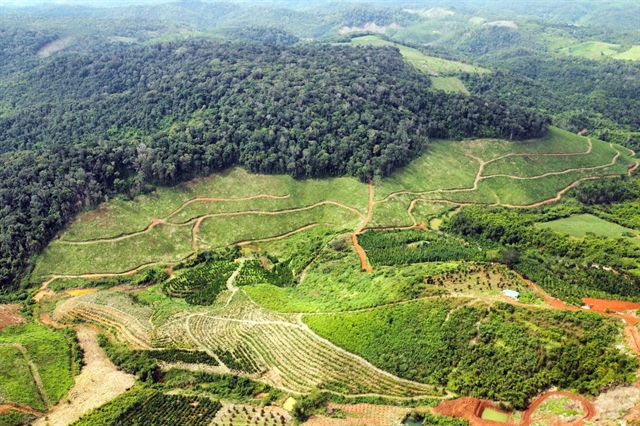 Economy
Economy

 |
| Forest coverage in Đắk Nông Province. — VNA/VNS Photo |
HÀ NỘI — Local areas with free land can more easily repurpose those spaces as tracts of forest, according to a new rule.
Deputy Minister of Agriculture and Rural Development Nguyễn Quốc Trị has issued a circular, introducing key changes that offer greater flexibility for localities in managing forest land conversion for other uses.
Circular No. 24/2024/TT-BNNPTNT revises and supplements provisions from Circulars 22/2023 and 25/2022, which regulate the planting of replacement forests.
A key change in Circular 24 is the provision that allows local areas with available land to designate forest production areas, including those managed by state-owned enterprises, for forest replacement planting.
This marks a departure from Circular 22/2023, which did not specify that state-owned enterprises could be designated as forest owners.
Instead, it grouped all types of economic organisations, such as businesses, cooperatives and other legally recognised entities under a broader category, excluding foreign-invested enterprises.
In addition, the new circular maintains the requirement that replacement forests must be planted on land designated for special-use forests, protective forests, or forest production areas, in accordance with the 2017 Forestry Law.
One of the significant changes introduced by Circular 24 is its provision to allow localities to receive funds for forest replacement planting from other regions that no longer have available land.
Previously, Circular 22 allowed only special-use and protective forests to be planted on land designated for these specific purposes.
Now, provinces and cities can plant replacement forests on land designated for forest production, offering more flexibility.
Circular 24 also revises the criteria for selecting localities and units that can receive funding for forest replacement.
The revised criteria now allow for the inclusion of areas with forest production land, in addition to those designated for special-use or protective forests.
In cases where multiple localities apply for funding, priority will be given to those with large areas of land that have not been designated for special-use forests, protective forests, or forest production, but where local budgets are insufficient to carry out planting.
The new circular also addresses issues related to project non-compliance.
If a project owner fails to carry out the required forest replacement planting, the provincial People's Committee is authorised to implement the planting using funds already deposited by the project owner into the provincial Forest Protection and Development Fund.
If the deposited amount is less than the prevailing unit price for forest replacement planting, the provincial People's Committee Chairman will notify the project owner of the price difference. The project owner must then pay the difference to the provincial fund within ten days of receiving the notice.
These changes aim to resolve problems that arose during the implementation of Circular 25/2022, providing localities and project owners with greater autonomy and clarity in executing forest replacement planting projects.
In addition to revising forest replacement planting regulations, Circular 24 offers guidance on managing investments in forestry projects, in line with Government Decree 58/2024/NĐ-CP.
The circular will come into effect on January 27, 2025.
Forest replacement planting has been a source of confusion for many localities. The Ministry of Agriculture and Rural Development discovered that, despite having available funds, localities struggled to use them effectively.
Deputy Minister Trị emphasised the need to address this issue urgently, warning that if left unresolved, it could lead to long-term challenges for localities due to fluctuating forest replacement costs and varying local conditions and development plans. — VNS




